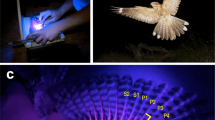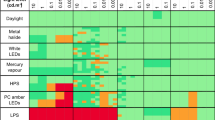Abstract
Sending color signals to conspecifics may attract predators, leading to opposing selection pressures on the evolution of signal expression and display behavior in animals. The costs of signaling can be reduced, however, because conspicuousness is the combined result of the reflectance spectra of the displayer's color pattern and the spectra of ambient light illuminating the animal. Changes in ambient light can alter conspicuousness, even when chemical and structural color-generating mechanisms remain constant, potentially allowing animals to display their colors most fully in light environments where the benefits are greatest relative to the costs. Using spectroradiometric methods, we determined how light habitat use affects conspicuousness in adult males of the Wire-tailed Manakin Pipra filicauda, a lekking bird species with vivid plumage colors. We studied three aspects of visibility, including properties of the entire color pattern, visual contrast within an individual's plumage and a bird's contrast relative to its visual background. Wire-tailed Manakins usually displayed in forest shade environments, which reduced their conspicuousness at larger viewing distances, while maximizing visual contrast within the plumage color pattern at close viewing distances. Compared to sunspots, ambient light in forest shade reduces the contrast of individual bird colors with the background at close viewing distance. However, background contrast of individual bird colors in the shade was still relatively higher during sunny than during cloudy weather which may explain why males were more active when the sun was not blocked by clouds. Assuming that the visual perceptions of predators and other manakins do not differ from the reflectance patterns we measured, Wire-tailed manakins tend to display in light environments that reduce the conflicts between avoiding long distance detection by predators and displaying conspicuous color signals to visiting females.









Similar content being viewed by others
References
Altmann J (1974) Observational study of behavior: sampling methods. Behaviour 49:227–267
Andersson M (1994) Sexual selection. Princeton University Press, Princeton, N.J.
Andersson S, Rydell J, Svensson MGE (1998) Light, predation and the lekking behaviour of the ghost swift Hepialus humuli (L.) (Lepidoptera: Hepialidae). Proc R Soc Lond B 264:1345–1351
Anhuf D, Winkler H (1999) Geographical and ecological settings of the Surumoni-Crane-Project (Upper Orinoco, Estado Amazonas, Venezuela). Anz Abstr I 135:3–23
Barlow GW (1976) The midas cichlid in Nicaragua. In: Thorson TB (ed) Investigations of the Ichthyofauna of Nicaraguan lakes. University of Nebraska Press, Lincoln, pp 332–358
Barry KL, Hawryshyn CW (1999) Effects of incident light and background conditions on potential conspicuousness of Hawaiian coral reef fish. J Mar Biol Assoc UK 79:495–508
Batschelet E (1981) Circular statistics in biology. Academic Press, London
Bowmaker JK, Heath LA, Wilkie SE, Hunt DM (1997) Visual pigments and oil droplets from six classes of photoreceptor in the retinas of birds. Vision Res 37:2183–2194
Butcher GS, Rohwer S (1989) The evolution of conspicuous and distinctive coloration for communication in birds. Curr Ornithol 6:51–108
Cherry MI, Bennett ATD (2001) Egg colour matching in an African cuckoo, as revealed by ultraviolet-visible reflectance spectrophotometry. Proc R Soc Lond B 268:565–571
Cuthill IC, Bennett ATD, Partridge JC, Maier EJ (1999) Plumage reflectance and the objective assessment of avian sexual dichromatism. Am Nat 160:183–200
Dale S, Slagsvold T (1996) Plumage coloration and conspicuousness in birds: experiments with the Pied flycatcher. Auk 113:849–857
Darwin C (1871) The descent of man and selection in relation to sex. Murray, London
Davies NB (1978) Territorial defence in the Speckled Wood Butterfly (Pararge aegeria): the resident always wins. Anim Behav 26:138–147
Endler JA (1978) A predator's view of animal color patterns. Evol Biol 11:319–364
Endler JA (1980) Natural selection on color patterns in Poecilia reticulata. Evolution 34:76–91
Endler JA (1984) Progressive background in moths, and a quantitative measure of crypsis. Biol J Linn Soc 22:187–231
Endler JA (1987) Predation, light intensity and courtship behaviour in Poecilia reticulata (Pisces: Poeciliidae). Anim Behav 35:1376–1385
Endler JA (1990) On the measurement and classification of colour in studies of animal colour patterns. Biol J Linn Soc 41:315–352
Endler JA (1991) Variation in the appearance of guppy color patterns to guppies and their predators under different visual conditions. Vision Res 31:587–608
Endler JA (1992) Signals, signal conditions, and the direction of evolution. Am Nat 39:S125-S153
Endler JA (1993) The color of light in forests and its implication. Ecol Monogr 63:1–27
Endler JA, Théry M (1996) Interacting effects of lek placement, display behavior, ambient light, and color patterns in three Neotropical forest-dwelling birds. Am Nat 148:421–452
Fleishman LJ, Persons M (2001) The influence of stimulus and background colour on signal visibility in the lizard Anolis cristatellus. J Exp Biol 204:1559–1575
Fleishman LJ, Bowman M, Saunders D, Miller WE, Rury MJ, Loew ER (1997) The visual ecology of Puerto Rican anoline lizards: habitat light and spectral sensitivity. J Comp Physiol A 181:446–460
Götmark F, Hohlfält A (1995) Bright male plumage and predation risk in passerine birds: are males easier to detect than females? Oikos 74:475–484
Grill CP, Rush VN (2000) Analysing spectral data: comparison and application of two techniques. Biol J Linn Soc 69:121–138
Guilford T, Dawkins MS (1991) Receiver psychology and the evolution of animal signals. Anim Behav 42:1–14
Haas R (1976) Sexual selection in Nothobranchius guntheri (Pisces: Cyprinodontidae). Evolution 20:614–622
Hart NS, Partridge JC, Cuthill IC (1998) Visual pigments, oil droplets and cone photoreceptor distribution in the European starling (Sturnus vulgaris). J Exp Biol 201:1433–1446
Heindl M (2002) Social organization on leks of the Wire-tailed Manakin in Southern Venezuela. Condor 104:772–779
Hunt S, Bennett ATD, Cuthill IC, Griffiths R (1998) Blue tits are ultraviolet tits. Proc R Soc Lond B 265:451–455
Jones JS, Leith BH, Rawlings P (1977) Polymorphism in Cepea: A problem with too many solutions? Annu Rev Ecol Syst 8:109–143
Kirk JTO (1994) Light and photosynthesis in aquatic ecosystems. Cambridge University Press, Cambridge
Kirkpatrick M, Price T, Arnold SJ (1990) The Darwin-Fisher theory of sexual selection in monogamous birds. Evolution 44:180–193
Lloyd JE (1975) Aggressive mimicry in Photurus: signal repertoire by femmes fatales. Science 187:452–453
Lythgoe JN (1979) The ecology of vision. Clarendon Press, Oxford
Moodie GEE (1972) Predation, natural selection, and adaptation in an unusual threespine stickleback. Heredity 28:155–167
Mottram JC (1915) Some observations of pattern-blending with reference to obliterative shading and concealment of outline. Proc Zool Soc 1915:679–692
Osorio D, Vorobyev M, Jones CD (1999) Colour vision of domestic chicks. J Exp Biol 202:2951–2959
Persons MH, Fleishman LJ, Frye MA, Stimphil ME (1999) Sensory response patterns and the evolution of visual signal design in anoline lizards. J Comp Physiol A 184:585–607
Pietrewicz AT, Kamil AC (1977) Visual detection of cryptic prey by blue jays (Cyanocitta cristata). Science 195:580–582
Reckardt R (2000) Phänologie einer Vogelgemeinschaft in einem Tieflandregenwald am oberen Orinoco (Estado Amazonas, Venezuela). Master's thesis, Martin-Luther-Universität Halle-Wittenberg, Halle, Germany
Rowe C (1999) Receiver psychology and the evolution of multiple-component signals. Anim Behav 58:921–931
Ryan MJ (1990) Sexual selection, sensory systems and sensory exploitation. Oxf Surv Evol Biol 7:157–195
Schwartz P, Snow DW (1978) Display and related behavior of the Wire-tailed Manakin. Living Bird 17:51–78
Sumner FB (1934) Does "protective coloration" protect? Results of some experiments with fishes and birds. Proc Natl Acad Sci USA 20:559–564
Vorobyev M, Osorio D, Bennett ATD, Marshall NJ, Cuthill IC (1998) Tetrachromacy, oil droplets and bird plumage colours. J Comp Physiol A 183:621–633
Walls GL (1942) The vertebrate eye and its adaptive radiation. Cranbrook Institute of Science, Bloomfield Hills, Mich.
Yamanouchi T (1956) The visual acuity of the coral fish, Microanthus strigatus (Cuvier and Valenciennes). Publ Seto Mar Biol Lab 5:133–156
Zahavi A (1975) Mate selection—a selection for a handicap. J Theor Biol 53:205–214
Zuk M, Decruyenaere JG (1994) Measuring individual variation in colour: a comparison of two techniques. Biol J Linn Soc 53:165–173
Acknowledgements
We gratefully thank M. Théry, R. Wagner, D. Blomqvist, two anonymous reviewers and the associate editor, J. Dickinson, for critical comments and discussions which greatly improved this manuscript. We also would like to thank C. Budde, C. Sandforth and G. Odenwälder for helping to net and band birds. H. Kühbauer and S. Laube gave valuable hints for the location of leks. This study was supported financially by the Austrian Fonds zur Förderung der wissenschaftlichen Forschung, project P11563-BIO. It was conducted as part of the collaborative research project of the Austrian Academy of Science and the Ministerio del Ambiente y de los Recursos Naturales Renovables in Venezuela. Treatment of birds complied with the current laws of the country in which research was performed (i.e. Venezuela).
Author information
Authors and Affiliations
Corresponding author
Additional information
Communicated by J. Dickinson
Rights and permissions
About this article
Cite this article
Heindl, M., Winkler, H. Interacting effects of ambient light and plumage color patterns in displaying Wire-tailed Manakins (Aves, Pipridae). Behav Ecol Sociobiol 53, 153–162 (2003). https://doi.org/10.1007/s00265-002-0562-3
Received:
Revised:
Accepted:
Published:
Issue Date:
DOI: https://doi.org/10.1007/s00265-002-0562-3




